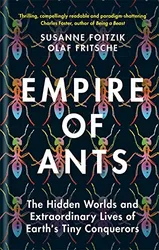Ants are fascinating creatures, living communally in a nest, with a way of life that’s very different from most of the creatures we’re more familiar with. Each chapter of Empire of Ants covers a different aspect of ant behaviour, such as the farming behaviour they perform with aphids and fungi, the ways in which ants are parasitized by various organisms, and the slave-making behaviour that some species of ants engage in. It’s written from the perspective of ant researchers, so there are lots of descriptions of how ants are studied in the field, how ant colonies are transplanted to the lab for further study, and the experiments that are carried out to help scientists understand ant behaviour. In some ways, it’s a little bit like The Genius of Birds but for ants.
A lot of what makes ant behaviour interesting is the genetics of ant reproduction, with the female workers quite prepared to give up their lives to help the colony, as this is the most effective way for them to help copies of their own genes to survive into the next generation. If you’ve read The Selfish Gene you’ll be familiar with this idea. Empire of Ants does a good job of relating ant behaviour to the unique genetics of an ant colony, and it covers the different ways that ant colonies reproduce.
For every interesting ant behaviour discussed, several example species are mentioned that exhibit that behaviour. There are sketches of some of the ants at the beginning of each chapter to illustrate, although to my untrained eye they don’t look that different from one another.
I was really interested to learn about ants’ sense of smell. I knew that they used scent trails to find their way to food and back to the nest, and to guide other ants too. But they seem to have both an incredible sense of smell and the ability to generate scent from their bodies. These abilities are put to all kinds of uses for communication and identification of other ants. It’s also scent that is used by parasites to infiltrate a nest, by mimicking the smell of the nest, or it’s larvae or queen.
I got the sense from this book that ants aren’t particularly smart as individuals, but that evolution has found lots of innovative ways for them to be successful as a collective. Some of these behaviours show a fascinating type of “group mind” behaviour, such as when scout ants go out and look for new sites for a nest. As more ants visit each of the possible sites, a consensus is built as to which is the best one, before all the ants move there. The nature of ant intelligence, relying on instinct passed down through the genes, seems to also make ants vulnerable to parasites and slave-making behaviours of other ants. Worker ants who have been stolen from one colony will start working inside the slave-makers’ colony as if nothing has happened, which to me suggests that they are not capable of realising that they are in the wrong nest.
Although a lot of the ant behaviours in the main chapters already seem strange compared to the creatures we are more familiar with, there is a chapter at the end dedicated to really strange behaviour. I was particularly surprised to learn about Wasmannia auropunctata, the electric ant or little fire ant. In this species the male and female basically reproduce separately, asexually, producing clones of themselves to form the next generation. But their genes do combine to make the workers. Very strange!
I really enjoyed this dig into the world of ants. It’s written with humour and I liked the personal touches about the life of an ant researcher. I learned a lot about these creatures and how they have adapted to many different environments.
